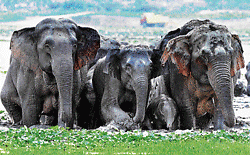A three-day National Elephant Census will begin on May 22 in Karnataka, Tamil Nadu, Kerala, Andhra Pradesh, Maharashtra and Goa, simultaneously.

The synchronised census, taken up once in five years, will be conducted throughout the country, following a directive issued by the Ministry of Environment and Forests.
Unlike the Elephant Reserve Census, where enumeration is restricted to counting of pachyderms in reserve forests, the synchronised census will be conducted in forest, non-forest, reserve and non-reserve forest areas (landscape-wise), said Ajay Mishra, Chief Conservator of Forests, Project Elephant, Karnataka.
As a preparatory exercise, senior officers of the Forest Department participated in a workshop conducted by elephant experts Raman Sukumar, Ajai Desai, M D Madhusudan, Surendra Varma and others, in Bandipur on May 10.
Dipak Sarmah, Principal Chief Conservator of Forests and Chief Wildlife Warden, said the department was issued guidelines for conducting the census.
“The workshop also included a field demonstration. Ground-level training will be imparted to the forest officials and volunteers taking part in the census,” he said.
The census will be conducted using three methods — block count, line transect dung count and waterhole count, said Surendra Varma, research scientist, Asian Nature Conservation Foundation.
The focus will be on estimating the elephant population during the particular season (with statistical confidence limits); number of elephants in broad age groups (adult, sub-adult, juvenile and calf); the ratio of males to females (bulls and cows) in respect of adult and sub-adult categories; the number of tuskers in respect of adult and sub-adult categories.
Wanted: ‘Good volunteers’
Varma said discipline was imperative for conducting the census. And to achieve this, it would be important to restrict the number of volunteers.
“If volunteers are involved, only one of them should be allowed per block or beat. More volunteers may result in counting more elephants. However, they can also become a source of disturbance in detecting and counting elephants. Volunteers should understand they aren’t going out for a picnic,” added Varma.
He said the department should focus on selecting volunteers “who are fit, knowledgeable, those who aren’t overly enthusiastic, and those with good cameras”.
“It will be helpful if the volunteers can share their photographs with the department at the end of the day’s exercise,” he said.
Counting will be done on May 22, 23 and 24 between 7 am and 5 pm.
Jumbo headcount 2007
Region Habitat (km) Corridors 2007 census
Northeast 41,000 36 9,330
North 5,500 12 1,726
East-central 23,500 20 2,633
South 39,500 20 14,005
Total 1,09,500 88 27,694
Note: Statistics published in the article ‘Current Status of Asian Elephants in India’ 2012 issue of journal ‘Gajah’. Authors - N Baskaran, Surendra Varma, C K Sar and Raman Sukumar.